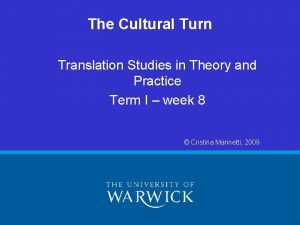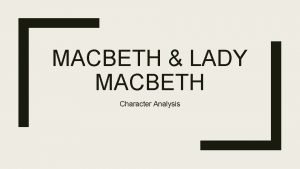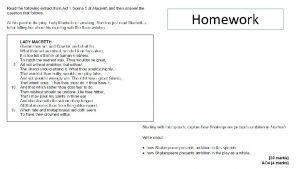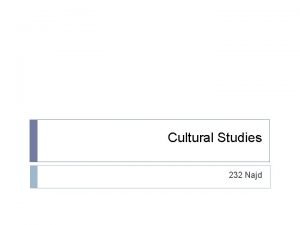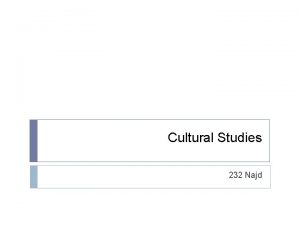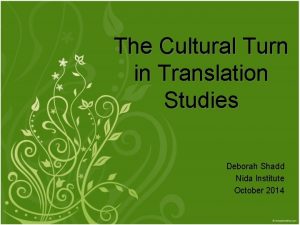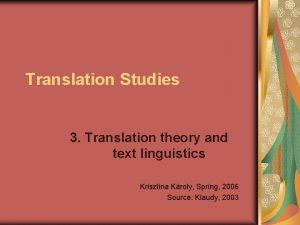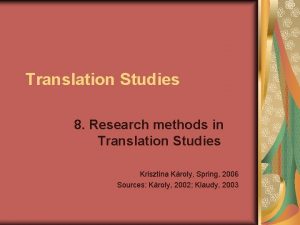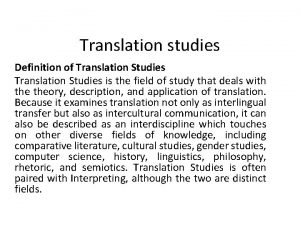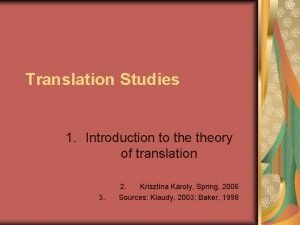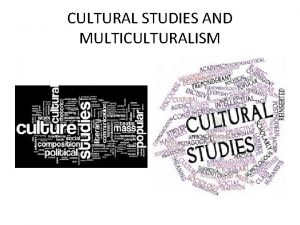The Cultural Turn Translation Studies in Theory and











- Slides: 11

The Cultural Turn Translation Studies in Theory and Practice Term I – week 8 © Cristina Marinetti, 2009

Chinese Tao, Te Ching 1. That which we look at and cannot see is called plainness That which we listen to and cannot hear is called rareness That which we grope for and cannot get is called minuteness These three cannot be closely examined; So they blend into One. Revealed, it is not dazzling; Hidden, it is not dark. Infinite, it cannot be defined. It goes back to non-existance. 2. Because the eye gazes but can catch no glimpse of it, it is called elusive. Because the ear listens but cannot hear it, it is called the rarefied. Because the hand feels for it but cannot find it, it is called infinitesimal. These three, because they cannot be further scrutinized, blend into one. Its rising brings no light; Its sinking no darkness. Endless the series of things without name. On the way back to where there is nothing.

A new orientation… away from equivalence ‘What is dominant in the series of new approaches, is the orientation towards cultural rather than linguistic transfer; secondly, they view translation not as a process of transcoding but as an act of communication; thirdly, they are all oriented towards the function of the target text (prospective translation) rather than prescription of the source text; fourthly, they view the text as an integrated part of the world and not as an isolated specimen of language. These basic similarities are so striking that it is not exaggerated to talk of a new orientation in translation theory. ’ (Snell-Hornby 82)

Positivism vs • Belief in the possibility of finding universal standards for phenomena • Standards for what makes a good translation ‘equivalence’ ‘tertium comparationis’ Relativity • Belief that phenomena are influenced (if not determined) by the observer • Meaning of the text depends on the conditions of reception

Translation, History and Culture • Standards are not unchangeable, but constantly affected by the changes in society through time by HISTORY • Focus not only on the word or the text or even the context but on CULTURE • The object of translation studies shifts from the focus on the binary source/target text to how translated texts function within and between complex and interconnected cultural systems.

Read the extracts from famous translator’s prefaces and try to guess nationality and historical period. Also comment on the type of relationship that they are constructing with their readers. 1. 2. 3. 4. Nicolas Perrot d’Ablancourt (1606 -1664) Leonardo Bruni (called Aretino) (1374 -1444) Friedrich Schleiermacher (1768 -1834) Edward Fitzgerald (1809 -1883)

Refractions ‘In other words, there is a vast process at work here, resulting in what we may call the refraction of literary texts. Refracted texts exist independently of the original, even though they are still linked to it, and they exist in a realm that is beyond the control of the author of the original. Nor is this all: for the great majority of readers one of those refractions actually functions as the original, is the original in the fullest sense of the word’ (Lefevere, On the refraction of texts, 217)

• Translations like all literary texts, set up a set of connections with the reader, a relationship based on co-operations and tacit understandings. • Translations function in the target culture as originals, they are in place of originals, especially when they are translations of central texts. Look at these three translations of the Odyssey and comment on their strategies. – – What type of refraction are they creating? What type of relationship are they setting up with the reader? – What textual strategies do they use to do so?

After the cultural turn… • Developments and criticisms of the cultural turn: – Focus on culture based on an unproblematic understanding of the notion of culture: • Migration, post-colonialism, gender highlighted the fractured, partial and constructed nature of culture (deconstructing notions of national cultures) – Cultural turn is another theory of translation at a time when most disciplines are questioning whether theory construction should be replaced by deconstruction and criticism (to be continued in week 10…)

The cultural turn: key texts • Bassnett and Lefevere, Translation, History and Culture, 1990 • Bassnett and Lefevere, Constructing Cultures, 1998 • Lefevere, Translation, Rewriting and the Manipulation of the Literary Fame, 1995. • Lefevere, ‘On the Refractions of Texts’. In Spariosu (ed. ) Mimesis in Contemporary Theory, 1984 • Snell-Hornby, Translation Studies: An Integrated Approach, 1995.

Cultural Turn: criticism and contextualization • Bonnell & Hunt ‘Introduction’. Bonnell (Ed) Beyond the Cultural Turn: New Directions in the Study of Society and Culture, 1999 • Singh ‘Unsafe at any Speed: some unfinished reflections on the ‘cultural turn’ in translation studies’. In St. Pierre& Prafulla (Eds) Translation – Reflections, Refractions, Transformations, 2007 • Snell-Hornby, ‘What's in a Turn? On Fits, Starts and Writhings in Recent Translation Studies’. Translation Studies, 2: 1
 Cultural turn translation studies
Cultural turn translation studies Tomato flames
Tomato flames Turn left right here
Turn left right here Wash your hands put on your nightgown analysis
Wash your hands put on your nightgown analysis Answer. go straight turn left turn right
Answer. go straight turn left turn right What is 1/4 turn clockwise
What is 1/4 turn clockwise Valiant macbeth quote
Valiant macbeth quote Macbeth seeing banquo's ghost quote
Macbeth seeing banquo's ghost quote Go straight ahead and turn left
Go straight ahead and turn left Turn hell hound turn
Turn hell hound turn One quarter turn clockwise
One quarter turn clockwise Go straight ahead and turn left
Go straight ahead and turn left
